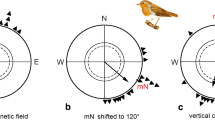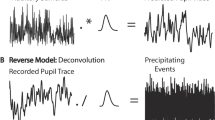Abstract
A three-dimensional model is proposed that accounts for a number of phenomena attributed to the otoliths. It is constructed by extending and modifying a model of vestibular velocity storage. It is proposed that the otolith information about the orientation of the head to gravity changes the time constant of vestibular responses by modulating the gain of the velocity storage feedback loop. It is further proposed that the otolith signals, such as those that generate L-nystagmus (linear acceleration induced nystagmus), are partially coupled to the vestibular system via the velocity storage integrator. The combination of these two hypotheses suggests that a vestibular neural mechanism exists that performs correlation in the mathematical sense which is multiplication followed by integration. The multiplication is performed by the otolith modulation of the velocity storage feedback loop gain and the integration is performed by the velocity storage mechanism itself. Correlation allows calculation of the degree to which two signals are related and in this context provides a simple method of determining head angular velocity from the components of linear acceleration induced by off-vertical axis rotation. Correlation accounts for the otolith supplementation of the VOR and the sustained nystagmus generated by off-vertical axis rotation. The model also predicts the cross-coupling of horizontal and vertical optokinetic afternystagmus that occurs in head-lateral positions and the reported effects of tilt on vestibular responses.
Similar content being viewed by others
References
Baarsma EA, Collewijn H (1975) Eye movements due to linear accelerations in the rabbit. J Physiol 245:227–247
Baloh RB, Richman L, Yee RD, Honrubia V (1983) The dynamics of vertical eye movements in normal human subjects. Aviat Space Environ Med 54:32–38
Barmack NH (1981) A comparison of the horizontal and vertical vestibulo-ocular reflexes of the rabbit. J Physiol 314:547–564
Benson AJ (1966) Modification of per and post-rotatory responses by the concomitant linear acceleration. In: 2nd symposium on the role of the vestibular organs in space exploration. NASA SP-115, Washington, DC, pp 199–213
Benson AJ (1974) Modification of the response to angular accelerations by linear accelerations. In: Kornhuber HH (ed) Psychophysics, applied aspects and general interpretations. Springer, Berlin Heidelberg New York (Handbook of sensory Physiology, vol VI/2, pp 281–320
Benson AJ, Bodin MA (1966a) Interaction of linear and angular accelerations on vestibular receptors in man. Aerosp Med 37:144–154
Benson AJ, Bodin MA (1966b) Comparison of the effect of the direction of gravitational acceleration on postrotational responses in yaw, pitch and roll. Aerosp Med 37:889–897
Benson AJ, Bodin MA (1966c) Effect of orientation to the gravitational vertical on nystagmus following rotation about a horizontal axis. Acta Oto-Laryngol 61:517–526
Benson AJ, Whiteside TCD (1961) The effect of linear acceleration on the response to angular acceleration in man. J Physiol (London) 156:6–7
Blanks RHI, Curthoys IS, Markham CH (1975) Planar relationships of the semi-circular canals in man. Acta Oto-Laryngol 80:185–196
Bodin MA (1978) The effect of gravity on human vestibular responses during rotation in pitch. J Physiol 196:74–75
Buizza A. Leger A, Droulez J, Berthoz A, Schmid R (1980) Influence of otolithic stimulation by horizontal linear acceleration on optokinetic nystagmus and visual motion perception. Exp Brain Res 39:165–176
Buizza A, Schmid R, Droulez J (1981) Influence of linear acceleration on oculomotor control. In: Fuchs A, Becker W (eds) Progress in oculomotor research. Elsevier, pp 517–522
Bullock TH, Orkland R, Grinnel A (1977) Introduction to nervous systems. Freeman, San Francisco
Cohen B, Suzuki J, Raphan T (1983) Role of the otolith organs in generation of horizontal nystagmus: effects of selective labyrinthine lesions. Brain Res 276:159–164
Correia MJ, Guedry FE (1966) Modification of vestibular responses as a function of the rate of rotation about an earth horizontal axis. Acta Oto-Laryngol 62:297–308
Correia MJ, Money KE (1970) The effect of blockage of all six semi-circular canal ducts on nystagmus produced by dynamic linear acceleration in the cat. Acta Oto-Laryngol 69:7–16
Crampton GH (1966) Does linear acceleration modify cupular deflection? In: 2nd symposium on the role of the vestibular organs in space exploration. NASA SP-115, Washington, DC, pp 69–184
Diamond SG, Markham CH, Simpson NE, Curthoys IS (1979) Binocular counterrolling in humans during dynamic rotation. Acta Oto-Laryngol 87:490–498
Favilla M, Ghelarducci B, Starita A (1980) The dynamic discharge properties of oculomotor neurons in rabbits with intact and canal-plugged labyrinths during sinusoidal lateral tilt. Neurosci Lett 16:35–39
Fernandez C, Goldberg JM (1971) Physiology of peripheral neurons innervating semicricular canals of the squirrel monkey. II. Response to sinusoidal stimulation and dynamics of peripheral vestibular system. J Neurophysiol 34:661–675
Fernandez C, Goldberg JM (1976) Physiology of peripheral neurons innervating otolith organs of the squirrel monkey. III. Response dynamics. J Neurophysiol 38:976–996
Fetter M, Hain TC, Zee DS (1986) Influence of eye and head position on the vestibulo-ocular reflex. Exp Brain Res (in press)
Goldberg JM, Fernandez C (1982) Eye movements and vestibular-nerve responses produced in the squirrel monkey by rotations about an earth-horizontal axis. Exp Brain Res 46:393–402
Goldstein H (1950) Classical Mechanics. Addison Wesely, Reading, Mass
Guedry FE (1965) Orientation of the rotation axis relative to gravity: its influence on nystagmus and the sensation of rotation. Acta Oto-Laryngol 60:30–48
Hain TC, Maria BL, Zee DS (1986) Modification ofthe dynamics of post-rotatory nystagmus by lesions of the cerebellum. In: Graham M (ed) The vestibular system: neurophysiologic and clinical research. Raven Press, New York (in press)
Hannen RA, Kabrisky M, Replogle, CR, Hartzler VL, Roccaforte PA (1966) Experimental determination of a portion of the human vestibular response through measurement of eyeball counterroll. IEEE Trans Biomed Eng 13:65–70
Harris LR, Barnes GR (1986) The orientation of vestibular nystagmus is modified by head tilt. In: Graham M (ed) The vestibular system: neurophysiologic and clinical research. Raven Press, New York (in press)
Hess BJM, Knopfel T, Precht W (1984) Dynamics of maculoocular reflexes in the frog. Neuroscience 11:645–650
Janecke JB, Jongkees LBW, Oosterveld WJ (1970) Relationship between the otoliths and nystagmus. Acta Oto-Laryngol 69:1–6
Jongkees LBW, Philipszoon AJ (1962) Nystagmus provoked by linear accelerations. Acta Physiol Pharmacol Neerl 10:239–247
Krejocova H, Highstein S, Cohen B (1971) Labyrinthine and extra-labyrinthine effects on ocular counterrolling. Acta Oto-Laryngol 72:165–171
Lansberg MP, Guedry FE, Graybiel A (1965) Effect of changing resultant linear acceleration relative to the subject on nystagmus generated by angular acceleration. Aerosp Med 36:456–460
Lorente de No' R (1932) The regulation of eye positions and movements induced by the labyrinth. Laryngoscope 42:233–330
Matsuo V, Cohen B (1984) Vertical optokinetic nystagmus and vestibular nystagmus in the monkey: up-down asymmetry and effects of gravity. Exp Brain Res 53:197–216
Matsuo V, Cohen T, Dejong V, Henn V (1979) Asymmetric velocity storage for upward and downward nystagmus. Brain Res 176:159–164
McCabe BF (1964) Nystagmus responses of the otolith organs. Laryngoscope 74:372
Miller EF II (1962) Counterrolling of the human eyes produced by tilt with respect to gravity. Acta Oto-Laryngol (Stockholm) 54:479–501
Mishkin S, Melvill Jones G (1966) Predominant direction of gaze during slow head rotation. Aerosp Med 37:897–900
Niven JI, Hixon WC, Correia MJ (1966) Elicitation of horizontal nystagmus by periodic linear acelleration. Acta Oto-Laryngol 62:429–441
Peterson BW, Baker JF, Wickland CM (1986) Spatial properties of the vestibuloocular reflex before and after labyrinthine lesions. In: Graham M (ed) The vestibular system: neurophysiologic and clinical research. Raven Press, New York (in press)
Raphan T, Cohen B (1983) Gravitational effects on visualvestibulo-oculomotor coordinate transformations generating compensatory eye movements. Society for Neuroscience Abstracts, Boston, Mass., Nov. 6–11, 13:316
Raphan T, Matsuo V, Cohen B (1979) Velocity storage in the vestibulo-ocular reflex arc (VOR). Exp Brain Res 35:229–248
Raphan T, Cohen B, Henn V (1981) Effects of gravity on rotatory nystagmus in monkeys. Ann NY Acad Sci 81:44–44
Raphan T, Waespe W, Cohen B (1983) Labyrinthine activation during rotation about axes tilted from the vertical. Adv Otorhinolaryngol 30:50–53
Robinson DA (1977) Linear addition of optokinetic and vestibular signals in the vestibular nucleus. Exp Brain Res 30:447–450
Robinson DA (1981) The use of control systems analysis in the neirophysiology of eye movements. Annu Rev. Neurosci 4:463–503
Robinson DA (1982) The use of matrices in analyzing the threedimensional behavior of the vestibulo-ocular reflex. Biol cybern 46:53–66
Schrader V, Koenig E, Dichgans J (1985a) The effect of lateral head tilt on horizontal post rotatory nystagmus I and II and the Purkinje effect. Acta Oto-Laryngol 100:98–105
Schrader V, Koenig E, Dichgans J (1985b) Direction and angle of active head tilts influencing the purkinje effect and the inhibition of postrotatory nystagmus I and II. Acta Oto-Laryngol 100:337–343
Wall C, Black OF (1984) The modulation component of nystagmus during earth horizontal rotation: relationship with gaze angle. Acta Oto-Laryngol 97:193–201
Woellner RC, Graybiel A (1959) Counterrolling of the eyes and its dependence on the magnitude of gravitational or inertial force acting laterally on the body. J Appl Physiol 14:632–634
Young LR (1967) Effects of linear acceleration on vestibular nystagmus. In: 3rd symposium on the role of the vestibular organs in space exploration. NASA SP-152, Washington, DC, pp 383–391
Young LR, Henn VS (1975) Nystagmus induced by pitch and yaw rotation in monkeys. Fortschr Zool 23:235–246
Young LR, Meiry JL (1967) A revised dynamic otolith model. In: 3rd symposium on the role of the vestibular organs in space exploration. NASA SP-152, Washington, DC, pp 363–368
Yuganov YM (1976) The problem of the functional characteristics and interaction of the otolith and cupular portions of the vestibular apparatus under conditions of altered gravity. In: Problems of Space Biology 4. NASA TT F-368, Washington, DC, pp 48–63
Author information
Authors and Affiliations
Rights and permissions
About this article
Cite this article
Hain, T.C. A model of the nystagmus induced by off vertical axis rotation. Biol. Cybern. 54, 337–350 (1986). https://doi.org/10.1007/BF00318429
Received:
Issue Date:
DOI: https://doi.org/10.1007/BF00318429




